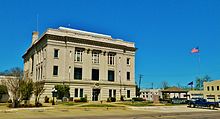Bryan County, Oklahoma
| Bryan County, Oklahoma | |
|---|---|

Bryan County Courthouse
|
|
 Location in the U.S. state of Oklahoma |
|
 Oklahoma's location in the U.S. |
|
| Founded | 1907 |
| Seat | Durant |
| Largest city | Durant |
| Area | |
| • Total | 944 sq mi (2,445 km2) |
| • Land | 904 sq mi (2,341 km2) |
| • Water | 39 sq mi (101 km2), 4.2% |
| Population (est.) | |
| • (2015) | 44,884 |
| • Density | 49.7/sq mi (19/km²) |
| Congressional district | 2nd |
| Time zone | Central: UTC-6/-5 |
Bryan County is a county located in the U.S. state of Oklahoma. As of the 2010 census, the population was 42,416. Its county seat is Durant. It is the only county in the United States named for Populist politician William Jennings Bryan.
Bryan County comprises the Durant, OK Micropolitan Statistical Area, which is included in the Dallas-Fort Worth and the Texoma region, TX-OK Combined Statistical Area. It is home to the headquarters of the Choctaw Nation of Oklahoma located in Durant.
Bryan County consists of 10 Townships: Albany, Bennington, Bokchito, Brown, Caddo, Calera, Colbert, Kemp, Matoy, and Speairs Townships.
The area now known as Bryan County was occupied by the Choctaw Tribe in 1831-2, and became part of Choctaw Nation's Blue County. In 1845, the tribe opened Armstrong Academy for boys near the community of Bokchito. The academy served as Chahta Tamaha, the Choctaw capital, during the Civil War. Bloomfield Academy, a school for Chickasaw girls opened in 1852, just south of the present town of Achille.
The Chickasaw tribe bought part of the Choctaw allocation prior to the Chickasaw migration to Indian Territory. The western quarter of today's Bryan County thus became part of the Chickasaw District in 1837. When the two tribes formally separated into two distinct nations in 1855, the Chickasaw District became the Chickasaw Nation.
The Butterfield Overland Mail and Stage route followed the older Texas Road across the present county during the late 1850s. General Albert Pike established Fort McCulloch for the Confederate Army near the present town of Kenefic on the Blue River. Although no Civil War battles occurred in the vicinity, the fort was garrisoned by more than a thousand Indian troops allied with the Confederates.
...
Wikipedia
